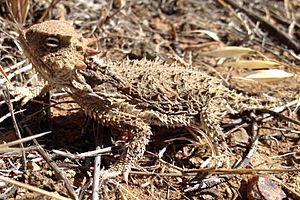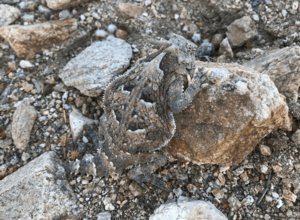Desert horned lizard facts for kids
Quick facts for kids Desert horned lizard |
|
|---|---|
 |
|
| Conservation status | |
| Scientific classification | |
| Genus: |
Phrynosoma
|
| Species: |
platyrhinos
|
The desert horned lizard (Phrynosoma platyrhinos) is a type of lizard found in western North America. People sometimes call them "horny toads," but they are actually lizards, not toads.
Contents
About the Desert Horned Lizard
Desert horned lizards have special features that help tell them apart from other horned lizards. They have large, pointed scales that stick out from the back of their heads. These scales look like horns. Their bodies are also flat and wide.
This lizard has a flat body with one line of fringe scales along its sides. It is a medium-sized lizard, growing up to about 3.75 inches (95 mm) long. It has one row of slightly bigger scales on each side of its throat.
Their colors can change to match the soil around them. They are usually beige, tan, or reddish on their back. They have wavy, darker spots. They also have two dark spots on their neck. These spots are very clear and have a light white or gray border behind them. They also have scattered pointed scales and other dark spots on their back.
Unlike some other horned lizards, the desert horned lizard does not have a clear stripe down its back. This stripe might be very faint or not there at all. Young lizards look like adults but have shorter, less noticeable "horns" on their heads. The horns of desert horned lizards are wide at the bottom. This is different from their relative, the Greater short-horned lizard.
What Desert Horned Lizards Eat
Desert horned lizards mostly eat small creatures without backbones, called invertebrates. Their favorite food is ants, including red harvester ants. They also eat crickets, grasshoppers, beetles, worms, flies, ladybugs, and mealworms. Sometimes, they eat a little bit of plant material too.
You can often find them near ant hills. They sit and wait for ants to walk by. Ants have a lot of chitin, which is hard to digest. This means ants are not very rich in nutrients. So, desert horned lizards need to eat many ants to get enough food. To help with this, they have big stomachs.
When they find soft sand, they shake themselves quickly. This throws sand over their backs, leaving only their head showing. This helps them hide from animals that might try to eat them. It also helps them wait for their food without being seen.
Where Desert Horned Lizards Live
Desert horned lizards live in many different places. The flat-tailed horned lizard lives in areas with fine sand. The short-horned lizard lives in shortgrass prairies and even in spruce-fir forests. The regal horned lizard likes rocky or gravelly areas in dry plains, hills, and lower mountains.
The desert horned lizard (P. platyrhinos) mostly lives in the Sonoran and Mojave deserts. You can find them in southeastern Oregon, California, western Arizona, Utah, and Nevada. Outside the United States, they are found in Mexico, northwestern Sonora, and northeastern Baja California. They like places with shrubs and plants to hide under. They often bury themselves in sandy soil. They might also live in burrows made by other animals.
Geographic Range and Subspecies
These lizards usually live from southern Idaho in the north to northern Mexico in the south. They are found in desert areas across western North America.
The places animals live can change because of climate change. The desert horned lizard has seen some changes since the Last Glacial Maximum (LGM). This was a very cold period that ended about 21,000 years ago. When the LGM ended, deserts grew bigger in western North America. This gave the desert horned lizard more places to live. They were able to move north into the Great Basin, which is now part of where they live today.
There are two types of desert horned lizards, called subspecies. They live in different areas:
- The northern desert horned lizard (Phrynosoma platyrhinos platyrhinos) lives in Idaho, Wyoming, Utah, Nevada, the Colorado front range, and parts of southeastern Oregon.
- The southern desert horned lizard (Phrynosoma platyrhinos calidiarum) lives in southern Utah and Nevada to southeast California, western Arizona, and northern Baja California.
Behavior
Desert horned lizards are usually calm. However, if you hold them, they might try to push their head spines into your hand. When they get excited, they puff themselves up with air. This makes them look bigger, like a Chuckwalla. If they see danger near a bush, they will quickly run into it to hide.
Unlike most other horned lizards, Phrynosoma platyrhinos usually runs away when it gets scared. But it often only runs for a short time before stopping again. Like some other horned lizard species, desert horned lizards can squirt blood from their eyes.
Scientists have also seen desert horned lizards collecting rain. This is a special behavior that only a few other species do. When collecting rain, the lizard changes its body position. This helps it get its mouth closer to the ground to drink the water.
Like other lizards in the iguana family, P. platyrhinos does different "displays." These displays are often used to show who is in charge, to be aggressive, or to find a mate. They can include push-ups, head bobbing, tail movements, and changing body posture. For the desert horned lizard, these displays are less about being aggressive. They seem to be more about recognizing other lizards of their own kind and for mating.
Some of these behaviors include different tail positions, like curled, between the legs, or arched down. They also do scratching, push-ups, and a "three-legged stance." In this stance, one back leg is held off the ground, and their back is shown to any predators.
See also
 In Spanish: Lagarto cornudo del desierto para niños
In Spanish: Lagarto cornudo del desierto para niños



